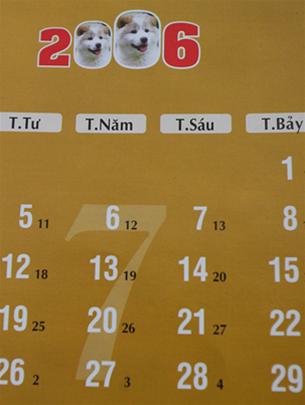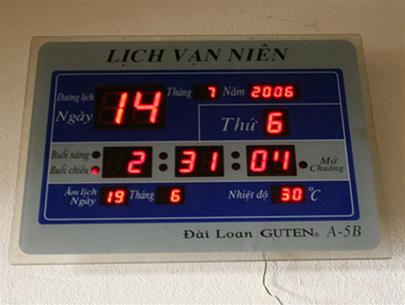From June 25 to July 24 of the Gregorian calendar, there is a one-day difference between the lunar calendars of Vietnam (VN) and China (TQ). Meanwhile, both the Vietnamese and Chinese calendars coexist in Vietnam. What causes this discrepancy, and how might it affect religious activities in Vietnam if based on the Chinese lunar calendar? Mr. TRỊNH TIẾN ĐIỀU, head of the State Calendar Department, explains:
– Specifically, June 25 on the Gregorian calendar corresponds to the first day of the sixth lunar month in the Vietnamese calendar, while in the Chinese calendar, it is the thirtieth day of the fifth lunar month.
Furthermore, June 26 on the Gregorian calendar is the second day of the sixth lunar month according to the Vietnamese calendar and the first day of the sixth lunar month according to the Chinese calendar. This discrepancy lasts until the end of the sixth lunar month, meaning that starting from July 25 on the Gregorian calendar, the lunar calendars of Vietnam and China will align again.
This phenomenon will reoccur next January (Year of the Pig). Specifically, February 17, 2007, will be the first day of the Lunar New Year according to the Vietnamese calendar, but according to the Chinese calendar, it will still be the thirtieth day of the Lunar New Year. Thus, next year, Vietnam will celebrate the Lunar New Year one day earlier than China.

On July 14 of the Gregorian calendar, while the Vietnamese calendar shows
the 20th of the sixth lunar month, the Chinese calendar (Wan Nian) shows the 19th of the sixth lunar month.
(Photo: V.Dũng)
* Sir, what is the reason for this discrepancy?
– The difference arises from the fact that Vietnam calculates time by adding 7 hours to Coordinated Universal Time (UTC), while China adds 8 hours, leading to a discrepancy in determining the lunar calendar.
In the lunar calendar, the first day of the month is a new moon day (called “sóc”). The new moon day of the sixth lunar month according to UTC begins at 4:06 PM on June 25 of the Gregorian calendar. To convert this to Vietnamese time, we add seven hours, making it 11:06 PM on June 25, which still falls within that day.
Thus, the Vietnamese calendar records the first day of the sixth lunar month as corresponding to June 25, meaning that the fifth lunar month only has 29 days, without a 30th.
Conversely, China, adding eight hours to UTC, sees the new moon beginning at 12:06 AM the following day. Therefore, the first day of the sixth lunar month in China is not June 25 but has shifted to June 26.
The difference in the lunar calendar for next January follows a similar pattern. The new moon in January next year according to UTC is at 4:15 PM, which, when added to the Vietnamese time, becomes 11:15 PM, still on February 17; thus, the first day of the Lunar New Year will coincide with February 17. In contrast, China, adding eight hours, will see the new moon at 12:15 AM, making the first day of the Lunar New Year fall on February 18.
However, for the seventh lunar month this year and the second lunar month next year, the new moon times according to UTC will still fall within the same Gregorian day, meaning that both Vietnam’s and China’s lunar months will have 30 and 29 days respectively. Therefore, there will be no discrepancy for the seventh and second lunar months.
* How long will the discrepancy between the lunar calendars of Vietnam and China occur?
– Our calculations suggest that the cycle of discrepancy in the lunar month between the two countries is 23 years. For instance, the discrepancy appears in January 2007. It will reoccur in 2030, 23 years later, and again in 2053, another 23 years after that. After this period, the discrepancies will no longer follow a cycle.

* Does this discrepancy affect the religious activities of the people?
– Currently, there may be two types of calendars in use among the populace. The 15 million block calendars printed this year rely on the data from the State Calendar Department, hence the lunar calendar is the Vietnamese one. In contrast, electronic calendars produced in China or certain calendars printed based on Chinese templates will follow the Chinese lunar calendar.
Although the lunar dates are different between the two calendars, the dates that people usually refer to for religious activities are based on the Heavenly Stems and Earthly Branches system, which aligns with the Gregorian calendar. Therefore, the Heavenly Stems and Earthly Branches dates for both Vietnam and China coincide, with no discrepancies affecting their significance.
For example, June 25 of the Gregorian calendar was the first day of the sixth lunar month in Vietnam and the thirtieth day of the fifth lunar month in China, but both correspond to the day of Đinh Dậu.
* Sir, what current issues are being raised regarding the Vietnamese calendar and the world?
– Currently, researchers in Vietnam and globally are calculating various plans to address the issue of missing days in the Gregorian February. As we know, February typically has 28 days, and leap years have 29 days, while other months have 30 or 31 days.
This difference causes certain inconveniences. For example, a person born on February 29 does not have a birthday three years later because those years only have 28 days in February. Therefore, people born on February 29 may find that for about 3/4 of their lives, they do not celebrate a birthday. Hence, researchers domestically and globally have proposed hundreds of reform plans for a new calendar that is scientific, simple, and easily understandable for everyone.
KHIẾT HƯNG reported

















































